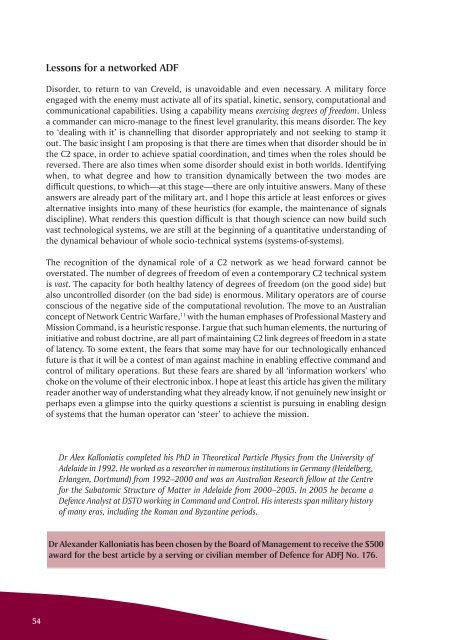ISSUE 176 : Jul/Aug - 2008 - Australian Defence Force Journal
ISSUE 176 : Jul/Aug - 2008 - Australian Defence Force Journal
ISSUE 176 : Jul/Aug - 2008 - Australian Defence Force Journal
Create successful ePaper yourself
Turn your PDF publications into a flip-book with our unique Google optimized e-Paper software.
Lessons for a networked ADF<br />
Disorder, to return to van Creveld, is unavoidable and even necessary. A military force<br />
engaged with the enemy must activate all of its spatial, kinetic, sensory, computational and<br />
communicational capabilities. Using a capability means exercising degrees of freedom. Unless<br />
a commander can micro-manage to the finest level granularity, this means disorder. The key<br />
to ‘dealing with it’ is channelling that disorder appropriately and not seeking to stamp it<br />
out. The basic insight I am proposing is that there are times when that disorder should be in<br />
the C2 space, in order to achieve spatial coordination, and times when the roles should be<br />
reversed. There are also times when some disorder should exist in both worlds. Identifying<br />
when, to what degree and how to transition dynamically between the two modes are<br />
difficult questions, to which—at this stage—there are only intuitive answers. Many of these<br />
answers are already part of the military art, and I hope this article at least enforces or gives<br />
alternative insights into many of these heuristics (for example, the maintenance of signals<br />
discipline). What renders this question difficult is that though science can now build such<br />
vast technological systems, we are still at the beginning of a quantitative understanding of<br />
the dynamical behaviour of whole socio-technical systems (systems-of-systems).<br />
The recognition of the dynamical role of a C2 network as we head forward cannot be<br />
overstated. The number of degrees of freedom of even a contemporary C2 technical system<br />
is vast. The capacity for both healthy latency of degrees of freedom (on the good side) but<br />
also uncontrolled disorder (on the bad side) is enormous. Military operators are of course<br />
conscious of the negative side of the computational revolution. The move to an <strong>Australian</strong><br />
concept of Network Centric Warfare, 11 with the human emphases of Professional Mastery and<br />
Mission Command, is a heuristic response. I argue that such human elements, the nurturing of<br />
initiative and robust doctrine, are all part of maintaining C2 link degrees of freedom in a state<br />
of latency. To some extent, the fears that some may have for our technologically enhanced<br />
future is that it will be a contest of man against machine in enabling effective command and<br />
control of military operations. But these fears are shared by all ‘information workers’ who<br />
choke on the volume of their electronic inbox. I hope at least this article has given the military<br />
reader another way of understanding what they already know, if not genuinely new insight or<br />
perhaps even a glimpse into the quirky questions a scientist is pursuing in enabling design<br />
of systems that the human operator can ‘steer’ to achieve the mission.<br />
Dr Alex Kalloniatis completed his PhD in Theoretical Particle Physics from the University of<br />
Adelaide in 1992. He worked as a researcher in numerous institutions in Germany (Heidelberg,<br />
Erlangen, Dortmund) from 1992–2000 and was an <strong>Australian</strong> Research fellow at the Centre<br />
for the Subatomic Structure of Matter in Adelaide from 2000–2005. In 2005 he became a<br />
<strong>Defence</strong> Analyst at DSTO working in Command and Control. His interests span military history<br />
of many eras, including the Roman and Byzantine periods.<br />
Dr Alexander Kalloniatis has been chosen by the Board of Management to receive the $500<br />
award for the best article by a serving or civilian member of <strong>Defence</strong> for ADFJ No. <strong>176</strong>.<br />
54

















